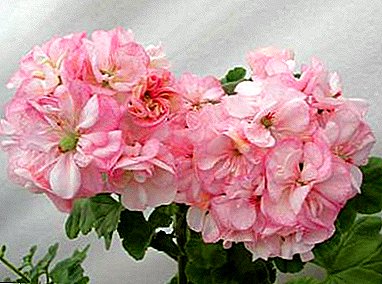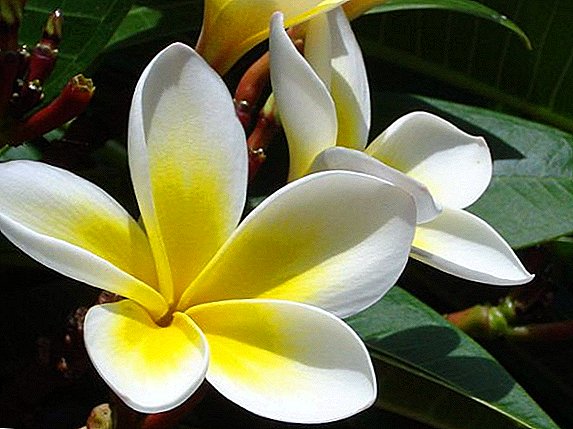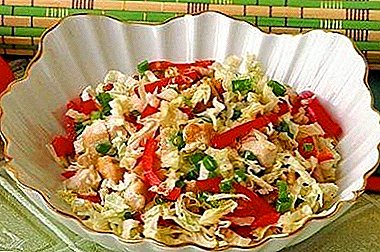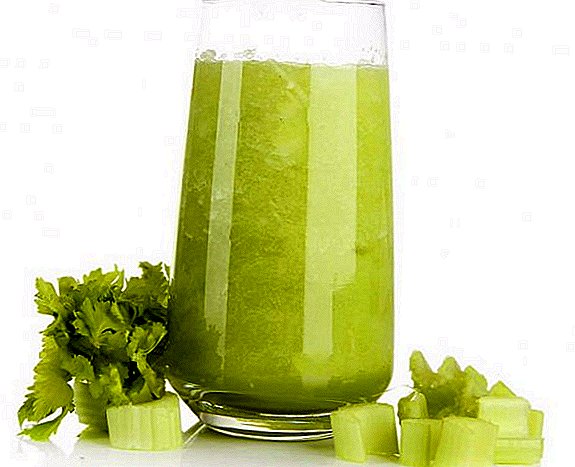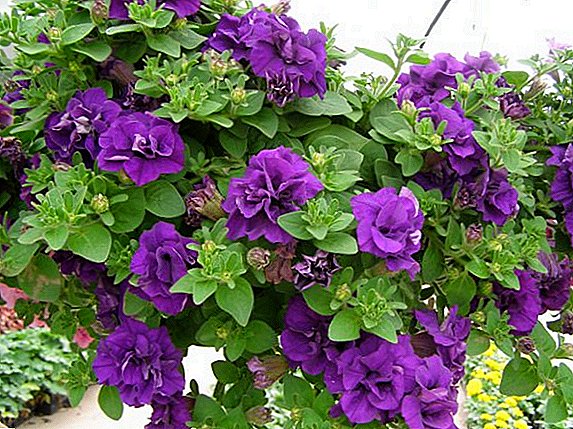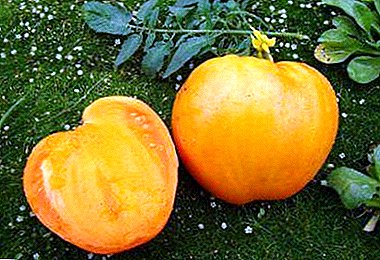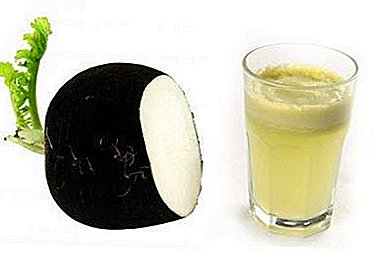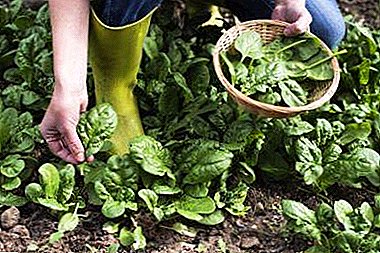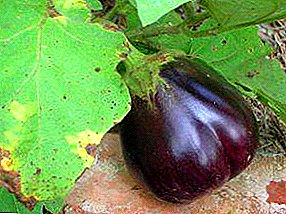
Cherry is a widespread culture in many countries around the world.
You can often find her in the expanses of the former USSR, including in Russian gardens and at the dacha plots.
This attitude of gardeners pushes breeders to create new and new varieties, with improved tree and fruit parameters. If you take into account the reviews of gardeners, then I consider many "one of the most advanced" variety of Chocolate Chocolate, the description and photo of which, as well as information on how to plant Chocolate Chocolate, can be found below.
Breeding history and breeding region
 This cherry refers to young and developing generation fruit culture.
This cherry refers to young and developing generation fruit culture.
Getting to the formation of a new species, experts All-Russian Scientific Research Institute of Breeding Fruit Crops (Orel) proceeded from the interest of Russian producers in such a fruit tree, which would satisfy two principal parameters - it would have a sufficiently high degree of frost resistance and would be low.
The first condition stemmed from the prospects for active breeding of Chocolatnits in horticultural farms in the Russian regions.
And, as is known, most of the territory of the Russian Federation is located in areas with a temperate and subarctic climate, at least, rather severe and problematic for effective cultivation of thermophilic fruit crops.
On the territory of Russia, the following sorts of cherries are the generous, Vladimirskaya, Moscow Griot.
As for the factor short staturethis requirement is the decree of the last decades when most gardeners strive to make their production most convenient and quick to return.
A low plant that is easy to maintain. without the use of special tools and additional equipment, is the best suited for this.
So in 1996, as a result of crossing a variety of late mutation Consumer black and cherries Lyubskaya a new beautiful and productive variety was obtained (authors - A. Kolesnikov, T. Trofimova, M. Miheeva).
 In the same year, Chocolate, which got its name for the characteristic chocolate color fruit was entered into the State Register for the Central Region of the Russian Federation.
In the same year, Chocolate, which got its name for the characteristic chocolate color fruit was entered into the State Register for the Central Region of the Russian Federation.
Besides winter hardiness and low growthThis cherry is marked by a number of other virtues, which will be discussed further.
Such varieties as Volochaevka, Morozovka and Vyanok show excellent winter hardiness.
Appearance of Cherry Chocolate
This variety is characterized by the following features that distinguish it from other types of cherries.
Tree
It has a relatively small growth, the maximum height of the tree varies on average within 2.1-2.5 m. The bark on the trunk (trunk) brown or gray-brown.
The plant is crowned with an average density of crown, quite compact and elevated above the ground, having the shape of an inverse (inverted) pyramid (with a sharp base and a wide blunt top).
Shoots. Grow into medium length. As a rule, straight. As on the trunk, on the main branches, the bark is brown with a grayish tinge. On shoots develop buds cone-shaped, about 3-4 mm long. The buds are in a tight position, close to the shoots.
 Leaves. Developing from the kidneys, they acquire the contour of an almost regular oval. The bicuspid leaves of the Chocolatnica have a pointed base and a rather blunt tip. Kept on the branches by means of a stem about 1.5 cm long. The bottom of the leaf is light, the top is dull dark green.
Leaves. Developing from the kidneys, they acquire the contour of an almost regular oval. The bicuspid leaves of the Chocolatnica have a pointed base and a rather blunt tip. Kept on the branches by means of a stem about 1.5 cm long. The bottom of the leaf is light, the top is dull dark green.
Flowers Pleasant white color, with loosely spaced petals. In one small inflorescence 3 flowers are collected, which contributes to good average yield. The calyx of a flower has the form of a small bell with strongly serrated sepals.
Fetus
Characterized by wide rounded shape and size of about 18-19 x 16-17 mm. The mass of a single cherry reaches 3.5 - 4 g.
Yellowish round bone in weight is one tenth of the total weight of the fetus. Ripe Cherry Chocolate gets a maroon color, which at the stage of full ripening of the fruit often turns into a rich black.
The fruit is not kept escaping with a stalk length of 32-36 mm. The dark red medium dense flesh of the cherry and the stone are well separated from each other.
Magnificent large fruits have Black Large, Volochaevka and Zhukovskaya.
A photo





Characteristic variety
Chocolate Cherry classified as self-fertile fruit crops - that means she can be fertilized by its own pollen and does not need additional pollinators.
Self-fertility also has the memory of Enikeeva, Mayak and Novella.
 However, in order to provide initially sufficiently productive "Chocolate" even higher yields, experienced gardeners and practitioners recommend planting a tree, an additional pollinator, next to the cherry of this variety.
However, in order to provide initially sufficiently productive "Chocolate" even higher yields, experienced gardeners and practitioners recommend planting a tree, an additional pollinator, next to the cherry of this variety.
In the process of pollination, Chocolate can be a good help. Cherry variety Griot and cherry varieties Vladimir and the bottle. If trees are planted in a group, for greater effect between them. Leave a clearance of at least 2-3 meters.
Fruit tree of this variety refers to enough heat-loving plants.
This means that it develops in the best way and gives the maximum possible yield, growing in the garden plot, well lit by the sun.
Experienced gardeners advise such a place to choose on the south side of the garden. It should be remembered that the presence of shade from nearby trees or a building can significantly reduce the yield of the Chocolate Woman.
Nevertheless, this grade is estimated by experts as quite hardy. In any case, this winter-hardy cherry is able to tolerate both very low temperatures and strong droughts.
To manage for a long time without irrigating the tree allows highly developed root system.
 Cherry blossoms usually begin in May. Already in in the middle - in the second half of July, the fruits of the Chocolate Woman ripen. The first harvest she usually gives gardener in the fourth year own life.
Cherry blossoms usually begin in May. Already in in the middle - in the second half of July, the fruits of the Chocolate Woman ripen. The first harvest she usually gives gardener in the fourth year own life.
With proper organization of agrotechnical measures and careful care, this cherry gives enough high yields.
According to statistics, the average yield of a variety is 78 centners of production per hectare (11-12 kg from one tree)The maximum yield was fixed at almost 97 centners.
Robin, Generous and Lyubskaya can boast excellent yields.
At the exit the tree forms a fruit with the following content chemical substances:
| Composition | amount |
|---|---|
| Sugar | 12,5% |
| Acids | 1,65% |
| Dry matter | 18,3% |
Ripe Fruit Chocolate usually very tasty. The characteristic bitterness is superimposed on the sweet and sour basic taste, which gives this cherry Cherry flavor.
However, the fruits of the variety are not only tasty, but also very healthy. In particular, they are rich in iron, cobalt, copper - substances that are actively involved in blood-forming processes.
 Present in the pulp pectin helps to effectively eliminate toxins from the body.
Present in the pulp pectin helps to effectively eliminate toxins from the body.
For nutritionists, Chocolate Chocolate is interesting because with its help appetite improvesit promotes effective to quench thirst and normalize the functioning of the intestines.
The fruits of Chernokorka, Zhivitsa and Kharitonovskaya varieties also possess excellent taste and benefit.
Planting and care
We learn how and where to plant the Chocolate Chocolate cherries correctly? Before the Chocolate Chocolate variety is planted, it is necessary pay attention to the groundOn which further landing and leaving is supposed.
Like most cherry varieties, Chocolate Chocolate loves not very sour sandy soils enriched with nutrients and provided with a good drainage system.
It is recommended to avoid planting wet lowlands and areas where groundwater is close (less than 1.5 m) to the surface. In addition, the landing site before planting a tree is desirable to fertilize with manure (humus).
It is very important to pay attention to the condition of the seedling. Experienced gardeners insist that seedlings should not be acquired "by hand".
At the same time, their external parameters should correspond exactly to the declared age.
 Planted chocolate trees either in April or in September. Dig a hole for each seedling with a diameter of 70 cm and a depth of 60-70 cm.
Planted chocolate trees either in April or in September. Dig a hole for each seedling with a diameter of 70 cm and a depth of 60-70 cm.
Manure, potassium chloride, superphosphate, and ash are added to the well.
In a pit fertilized in this way, the seedling is lowered, its roots are covered with soil and the soil is trampled down around the trunk.
Water the planted plant with better defended soft water. Pistol area it is necessary to mulch with humus and sawdust.
Proper care of the Chocolate Chocolate variety suggests regular irrigation, as well as timely weeding, loosening and fertilizing the soil.
In the spring, for 22-27 days before the swelling of the kidneys, should cut dried and damaged branches.
During flowering and ripening need to provide the tree good watering - up to 3-4 buckets of water under every tree.
It is also necessary to apply the necessary fertilizers to the soil in time.
Spring is the time of nitrogen fertilizers, but phosphate and potash fertilizers are added in the fall. In the vegetative period, infusion of mullein and mineral fertilizers are introduced.
If the growth of seedlings each year is not less than 70 cm, it means that the tree develops correctly.
Diseases and pests
 This variety, like many other varieties of cherries, love to nibble in the winter. various rodents. To protect the bark from these pests, it is recommended before the cold wrap the barrel with a coarse cloth.
This variety, like many other varieties of cherries, love to nibble in the winter. various rodents. To protect the bark from these pests, it is recommended before the cold wrap the barrel with a coarse cloth.
As for the diseases, fungal diseases such as coccomicosis and moniliasis.
A factor indicating the infection of a tree by spores of the fungus Blumeriella jaapii (Sossomuse hiemalis) is the appearance of reddish spots on the leaves and not the season before their extensive fall.
This does not lead to the immediate death of the plant, but the tree suffering from the aforementioned ailment gradually weakens and nevertheless dies out prematurely, unable to survive the winter frost.
The fight against coccomycosis is in sequential processing of wood with fungicides: the first time is before bud break, the second is during flowering, closer to its end, the third is 2-3 weeks after the end of flowering (or according to the situation, if red spots on the leaves continue to appear).
The varieties Tsarevna Felt, Ashinskaya Steppe and Tamaris are resistant to this scourge.
Monilias disease, the causative agent of which is the asilomycete fungus Monilia, received its second name - monilial burn - due to the fact that dried branches appear abundantly on the trees affected by it.
If for several years you do not begin to fight this disease, the plant will gradually weaken and die.
 To take care of the health of future fruitful trees should not yet be the stage of selection of seedlings.
To take care of the health of future fruitful trees should not yet be the stage of selection of seedlings.
"Prevention" includes the choice of a well ventilated place for planting, mandatory processing of trunks and branches damaged as a result of mechanical action, periodic thinning of the thickened crown.
If the tree could not be protected from infection, then it should be treated as soon as possible.
For this over several seasons stone crop processing must be performed fungicides - before, during and after the end of the flowering period.
In order to minimize the possible ingress of fungus on neighboring trees, chemical treatment and pruning of the branches should be carried out. only in windless dry weather.
Thus, in order to fully enjoy the taste of one of the most beautiful and fragrant cherries, you will have to put a lot of effort. But isn't Chocolate Chocolate worth it?
Watch a useful video about what conditions are required for fruiting cherries? How to protect cherries from pests? What are the most disease resistant varieties?


